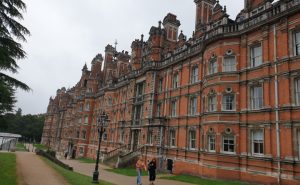
Friday 21st June was EO Day, a day set up by the Employee Ownership Association to help employee owned companies celebrate being, well, employee owned! The theme of the day was #ProudlyEO. Today, 1st July, marks Merlin’s 8th year of being EO.
To celebrate, the staff at Merlin took to the surrounding hills near our office in Ledbury and were lead on a geo-walk by Andy Sims. Taking in the beautiful views and learning about the local geology as a team seemed the perfect way to mark the day.

We visited various quarries along our walk. The first stop was just off Worcester Road, and consisted of folded Much Wenlock Limestone, Figure 1. This limestone was muddy, unfossiliferous and contained distributed small fractures. At the top of Figure 1 you can clearly see two darker beds that have been eroded out with limestone overhanging them. These are bentonite volcanic layers. You often see multiple of these beds when they outcrop, as in this example.



The second quarry was just off Knapp Lane. It contained Aymestry Limestone which is composed of carbonate nodules within muddy facies, Figure 2a. The limestone is offset across the valley so this is likely to be a fault. At other locations the limestone is more muddy with fewer nodules than what is seen at this location. We found a few corals (Figure 2b), shells including bivalves and brachiopods (Figure 2c) and bentonite beds (Figure 2a).

The third quarry was our last before lunch, and we foraged for fossils within the Upper Wenlock Shale (Figure 3).


After lunch at a lovely village pub, we rejoined the path again along the West edge of Frith Wood. Our final quarry location had a great outcrop of Upper Ludlow Shales (Figure 4a). These shales are the last truly marine sections before shoreline and fluvial facies were deposited. We spotted storm beds with convex upward sedimentary swells as well as more fossils including orthocones and bivalves (Figure 4b). Trilobites can also be found here, but none were discovered on our trip this time.

On the walk back, we had stunning views over Herefordshire towards Much Marcle (Figure 5). We walked over Downton Castle Sandstone and distinctive red Raglan Mudstone.
Overall, everyone enjoyed the geo-walk as we discovered how complex the local geology is, with major faulting and folding creating multiple beds dipping in several directions that are difficult to decipher and map. Foraging for our own fossils is always good fun and topped off with good weather and a pub lunch, no one could think of a better way to celebrate being employee owned.
For those of you who tuned in for our normal Monday morning technical post, the last in our series on Navigating Carbon Dioxide Plume Flow in the Subsurface, A Reservoir Engineers Perspective, you will be pleased to hear it will be with you this Thursday.


